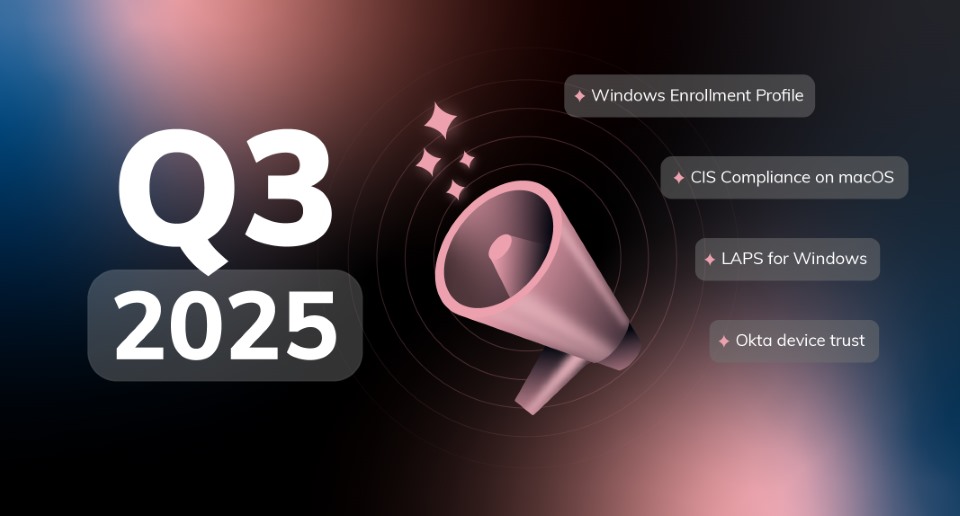EDR Explained: A Complete Guide to Modern Endpoint Security
Endpoint Detection and Response (EDR) protects endpoints from cyber threats with real-time detection and rapid response.

Get fresh insights, pro tips, and thought starters–only the best of posts for you.
Elaine Claire
Oct 22, 2025
7 min read

We’re heading into the final stretch of 2025, but Hexnode isn’t slowing down anytime soon. This quarter brought a wave of updates focused on tightening security, enhancing automation, and giving IT teams more control across every platform.
On October 15th, 2025, we hosted our latest What’s New with Hexnode (WNWH) session—showcasing fresh features, live demos, and a peek at what’s next for the Hexnode ecosystem.
Hexnode’s new Alerts Profiles let admins define and automate alerts for key events across a vast range of sources. From compliance breaches to domain configurations, these profiles ensure IT teams are notified instantly. Hence, no more manual checks or missed issues.
Built for proactive management, Alerts Profiles help admins centralize monitoring, reduce response time, and maintain full visibility across their fleet.
Where it helps:
Device onboarding just got even smarter. Hexnode expands Enrollment Profiles to Windows and rolls out Phase 2 for Android, giving IT teams the power to predefine setup configurations that apply instantly during enrollment.
This update streamlines large-scale deployments and ensures consistency across every managed device—corporate or BYOD.
Where it helps:
Hexnode now supports CIS (Center for Internet Security) Compliance for macOS, enabling organizations to align their devices with globally recognized security benchmarks.
Admins can apply CIS-recommended configurations, track compliance, and generate reports that map to standards like NIST, HIPAA, and ISO 27001, helping enterprises strengthen their security posture and stay audit-ready.
Where it helps:
Hexnode LAPS (Local Administrator Password Solution) brings local administrator password management directly into the Hexnode UEM console. Unlike Microsoft’s LAPS, which depends on Entra ID or Active Directory, Hexnode LAPS operates independently —generating, rotating, and securely storing unique local admin passwords for each managed device. Each endpoint gets its own unique, securely stored credential, eliminating the risks of shared or static passwords.
Admins can view or reset credentials within Hexnode, set rotation schedules, and enforce password complexity rules. It’s a simple but powerful way to boost compliance and endpoint protection.
Where it helps:
The new Okta Device Trust integration ensures only compliant, secure devices can access corporate resources. Hexnode shares real-time compliance data with Okta, which then applies FastPass and Device Assurance policies that verify both the user and the device before access is granted.
This integration removes the need for complex certificate setups while supporting a seamless user experience—paving the way for true Zero Trust access.
Where it helps:
The Hexnode Store brings together an exclusive collectionof enterprise-ready applications accessible directly from the Hexnode portal. Featuring over 400 curated business apps not offered on native app stores, it allows customers to deploy and manage essential software right from the console.
By bringing these applications under one secure platform, Hexnode Store helps organizations simplify software deployment, maintain version consistency, and accelerate rollout times.
Where it helps:
Hexnode introduces Offline Patches, enabling enterprises to deploy updates through a local network instead of the internet. Using the DAFS (Distributed Application File System) server, patches are downloaded once and distributed internally, reducing bandwidth consumption and improving patch delivery speeds.
Ideal for large-scale or high-security environments, Offline Patches make it easier to keep devices up to date without straining network resources.
Where it helps:
This quarter, Hexnode took a bold step forward with two major innovations that expand its reach beyond traditional UEM—Hexnode XDR and Hexnode Dex. These solutions reflect Hexnode’s evolving vision of unified endpoint and security management, bringing deeper visibility, smarter automation, and a stronger focus on both protection and user experience. Together, they mark a significant milestone in Hexnode’s journey toward creating a more intelligent, secure, and employee-centric IT ecosystem.
Hexnode XDR (Extended Detection and Response) unifies threat detection, investigation, and response across managed endpoints. By correlating data from devices, apps, and user activity, it delivers real-time visibility into potential risks and automates remediation to minimize impact.
This platform empowers IT and security teams to act proactively, identifying threats before they escalate and strengthening the organization’s overall resilience against modern cyber threats.
Hexnode Dex focuses on enhancing how employees interact with workplace technology. It gives IT teams complete visibility into device health and user experience metrics, allowing them to diagnose issues, automate fixes, and ensure a seamless digital workspace.
With Dex, organizations can move from reactive problem-solving to proactive experience management—boosting productivity, reducing downtime, and creating a frictionless digital environment for every employee.
That’s a wrap for Q3! From smarter automation to deeper integrations, these updates continue to make Hexnode a more powerful and cohesive UEM platform.
Missed the live session? No worries—the full webinar recording is available anytime. Catch the on-demand session here!
We’ll be back soon with our next round of innovations in the Q4 WNWH. Stay tuned—there’s plenty more in store to make device management even better.
Try out our 14 day free-trial to get first-hand Hexnode experience.
Try out now